
* 23 entries including: torpedoes, responsive space revisited, Chinese defense buildup, dangers of derelict munitions dumps, ultra-high performance concrete, hospitals work to improve cleanliness, collective memory of weaver ant colonies / superb ant sense of smell, disability as a business opportunity, revised thinking about origins of Earth's Moon, new global brand names from developing economies, quantum-dot display systems, and Getty Images dominates the photo licensing market.

* NEWS COMMENTARY FOR OCTOBER 2012: While American hardliners have sniped about the Obama Administration's "weakness" over Iran and that nation's nuclear program, THE ECONOMIST reports that Iranians don't see themselves as being handled gently. The Iranian rial has fallen in value by 80% or more since the beginning of 2012, with most of that collapse in October. Unemployment has skyrocketed, with some observers suggesting that about a third of Iran's labor force is out of a job, while prices have surged to painful levels as well.
To be sure, many of Iran's problems can be laid at the door of the inept government of Iranian President Mahmoud Ahmadinejad, but of course US-led Western sanctions -- discussed here early this year -- are adding considerable pressure. Israel's finance minister, Yuval Steinitz, believes the Iranian economy is "on the verge of collapse."
However, the Israelis also believe that Iran might well be capable of producing a nuclear weapon sometime in 2013. Iran has a semi-authoritarian government and so can more easily weather stresses that would mean a quick change of regime in nations with popular government. The crankish Ahmadinejad is on the way out; he is finishing his second term and cannot run for a third term in the presidential elections next year. It is believed many of his political cronies will follow him out of office, but few think that the next Iranian administration will amount to a substantive "regime change". Supreme Leader Ali Khamenei, who has the final say on the big issues, speaks of developing a "resistance economy" that will allow Iran to continue on track.
It's hard to think of a "resistance economy" as amounting to anything more telling Iran's citizens to "toe the line and deal with it". The pity is that the Obama Administration doesn't really want to put the squeeze to Iran's people -- but it's equally hard to think there was any way to avoid doing so. In any case, if Obama is reelected, come the spring he may have some even harder choices to make.
* The Transportation Security Administration (TSA), which handles security for American airports, is held in the least esteem of any US public-safety service, citizens having a generally low opinion of the TSA's competence and civility. A note in BUSINESS WEEK magazine did nothing to enhance the TSA's reputation by describing the service's "Screening Passengers by Observation Technique (SPOT)", a set of procedures in which TSA personnel are trained to recognize suspicious characters from dodgy behavior.
SPOT sounds like a notion prone to difficulties, and it has not worked out well in practice. It has helped pile up arrests, with over a thousand people busted on TSA referrals since 2004 -- TSA people can't make arrests, by the way, they have to ask the police to do it. The problem is that all those arrests haven't nabbed a single terrorist, with about two-thirds of those busted being nailed on drug or immigration charges, or caught on outstanding criminal warrants.

Homeland Security Secretary Janet Napolitano defended the TSA, saying: "Nothing we're doing in the aviation environment is for the heck of it. It's being done in response and to deal with ever-evolving threats." Nobody could dispute that statement, but there remains the awkward question of the quality of implementation. Civil liberties advocates have criticized TSA for using SPOT as a pretext to single out minorities, the critics also suggesting that TSA staffers have been inclined to be obnoxious as a way of pretending they're doing a good job. Napolitano's protest notwithstanding, outside consultants have been brought in to give SPOT a looking over and suggest better ways of doing things.
* As reported by WIRED.com, the FBI scored what did seem to be a blow against terrorism through the arrest of Quazi Mohammad Rezwanul Ahsan Nafis, a 21-year-old Bangladeshi national in the US on a student visa, who the authorities claimed planned to blow up the Federal Reserve Building in New York City with a car bomb.
The details make the feat sound somewhat less impressive. Nafis arrived in America in January and promptly started hunting around for someone, anyone, to help him pull off a terrorist action, even discussing possibilities on his Facebook page. It pays to advertise of course, and by July Nafis had indeed made contact with a sympathetic soul -- actually an FBI informant -- who got him in touch with an "al-Qaeda operative" -- actually an FBI agent. The FBI agent was remarkably helpful, providing Nafis with bags of fake explosives, a van, and storage space. Go time was set for 17 October 2012, Nafis hoping to disrupt the US presidential election.
The closest Nafis came to getting suspicious was to ask the FBI agent if al-Qaeda was actually behind the operation, the reply of course being YES. Nafis considered going back to Bangladesh to see his family one last time, but the FBI agent talked him out of it. On 17 October, the two drove the car bomb over to the Federal Reserve Building and parked it there. They then rented a room at a nearby hotel where the agent recorded Nafis' "martyrdom video". That completed, Nafis phoned the "cellphone detonator" to set off the bomb, with the call recorded by the authorities, who promptly arrested him.
The story has some credibility problems, and the level of assistance the FBI admits they provided to Nafis might well give him a lever to plead innocence on the basis of entrapment. Details should be established at Nafis' trial. The tale seems more plausible to anyone who's ever dealt with, say, conspiracy theorists and noted their revolutionary zeal, as well as their complete lack of sense. Most noisy firebrands are all loud talk -- but it's easy to imagine the humorous aspects of what would happen if one crossed the line to actually try to do something. What makes the matter less humorous is, of course, that a fool can be just smart enough to be dangerous.
COMMENT ON ARTICLE* THE BOMBS IN THE BACKYARD: There's been much concern given over the past few decades to "mine pollution" -- the unfortunate tendency of armed conflicts to leave mines strewn over the landscape that can main and kill for decades. However, as reported by an article from THE ECONOMIST ("Storing Up Risk", 29 September 2012), there's a related problem that doesn't get much attention: widely dispersed ammunition dumps that have a tendency to brew up for various reasons.
Since people began tracking the issue in 1995, about 4,600 people have been killed in ammunition dump explosions. 442 were killed by 46 explosions in 2011, establishing a record. In March 2012, an explosion in Congo-Brazzaville killed 250, showering munitions over several square kilometers. There are thousands of poorly run munitions depots in unsettled parts of Africa and the Middle East, with the dumps often sited disturbingly close to towns and cities. The collapse of the USSR also left a staggering number of derelict munitions dumps all over the former Soviet empire. Moldova spends a quarter of its defense budget just guarding old munitions dumps; Ukraine alone has about a half million tonnes of old munitions lying around.
Military forces of necessity prefer high explosives that are stable; however, propellants used to fire shells are not so stable, tending to degrade, particularly in hot weather, until something bad finally happens. When ammunition dumps are properly maintained, propellant stockpiles are checked periodically and replaced when necessary. Poor countries may simply trust to luck, and they may also not be inclined to dispose of munitions that are too expensive for them to replace. Mismanaged weapons dumps also present opportunities to thieves and dodgy customers; there's a persistent worry about terrorists getting their hands on shoulder-launched surface-to-air missiles and shooting down jumbo jetliners. Libya is a particular problem child, since Muammar Qaddafi, the country's late dictator, spread his munitions around to over 500 supply points to dodge NATO air strikes.
The quickest way to dispose of weapons is to blow them up in a hole in a remote location, but that's trickier than it sounds, since the munitions have to be carefully stacked up to make sure they're all destroyed. That's not really practical for big stockpiles, and there's also potential environmental fallout from simply blowing them up. One concept being explored is to extract explosives from casings and burn them incrementally, but that's obviously tricky as well, and so far hasn't been put to major use.
Landmines remain a bigger problem, with estimates that about five times as many people are killed by mines as by ammunition dump explosions. However, about a hundred times more money is spent on dealing with mines than on ammunition dumps. The issue of menacing ammunition dumps obviously needs a bit more attention.
COMMENT ON ARTICLE* RESPONSIVE SPACE REVISITED (1): The US military's interest in "operationally responsive space (ORS)" -- fast-track launches of low-cost satellites -- was last discussed here in 2011. Despite a tight funding environment, global interest in the concept seems to be lively, as demonstrated by an article from AVIATION WEEK ("Light Sats" by David Eshel, 13 August 2012), that discussed Israeli work towards an ORS capability.
Rafael Advanced Defense Systems is now developing a microsatellite platform named "LiteSat" that will have a maximum launch mass of 100 kilograms (220 pounds), using leading-edge composite materials to reduce weight, and a stowed form factor of 30 x 150 centimeters (1 x 5 feet). The primary mission is envisioned as optical reconnaissance, with the LiteSat placed into a high-inclination orbit with an altitude of 400 kilometers (250 miles). The payload will include panchromatic and thermal infrared imagers providing imaging resolution of less than a meter. The LiteSat will have a service life of up to seven years.
Rafael is also working on reduced-weight LiteSat with a launch mass of 85 kilograms (190 pounds), using solar-powered ion electric Hall-effect drives instead of traditional hydrazine thrusters. Rafael has developed the Hall-effect drives for VENUS (meaning, more or less, "Vegetation & Environment Monitoring New Microsatellite"), an environmental microsatellite being developed in collaboration with France for launch in 2014. VENUS will be a larger minisatellite, with a launch mass of 240 kilograms (530 pounds), based on the Israel Aerospace Industries' Improved Multi-Purpose Satellite (IMPS) bus. It will be launched as a secondary payload, possibly on a Russian booster.
The launch vehicle envisioned for the LiteSat will be a derivative of the "Silver Sparrow", itself an improved derivative of the "Blue Sparrow" target used to test Israel's Arrow anti-ballistic missile. The Sparrow targets -- no honest relation to the classic American Sparrow air-to-air missile -- are launched from an Israeli Air Force F-15 Eagle fighter. Air launch promises more flexibility than the Israelis are used to: being crowded by neighbors, some not at all friendly, on three sides has forced them to ground-launch spacecraft west over the Mediterranean, which not only imposes a penalty for launch into high-inclination orbits, but also imposes a penalty because the launch path flies against the rotation of the Earth.
One might speculate on the Israelis working with an African ally, notably Ethiopia, to obtain an advanced base for satellite launches over the Indian Ocean, which would provide a wide-open range for shots into orbit on a due-south trajectory. There's been a lot of interest in use of air launch for ORS; given the geographic constraints the Israelis have to deal with, it would not be surprising if they were to take a lead in it.
Of course, the LiteSat bus could be used to support other payloads for military or civil use. The Asher Space Research Institute at the Technion-Israel Institute of Technology is also working on a scheme in which a constellation of three nanosatellites will be flown in 2015, the nanosats being intended to demonstrate precision formation-keeping and the ability to triangulate the precise location of a ground beacon.
The demonstration mission is envisioned as leading to operational constellations for signals intelligence, search and rescue, and even imaging radar missions -- the radar presumably having a "multistatic" configuration, in which one satellite is the transmitter while the others act as receivers. Interferometric techniques would give the radar constellation the effective resolution of an antenna with a diameter equivalent to the spacing of the nanosats. It would not give the signal sensitivity equivalent to such an antenna, however, suggesting that the receiver satellites would have large, lightweight furlable antennas to increase their individual sensitivity. [TO BE CONTINUED]
NEXT | COMMENT ON ARTICLE* THE TORPEDO (14): At the end of the First World War, the US Navy had two types of torpedoes in inventory, the 45-centimeter (17.7 inch) "Mark 7", for both submarine and surface launch, and the 53.3-centimeter (21-inch) "Mark 8". Torpedo development continued in the postwar period through a series of improved marks.
In the 1930s the US Navy, having taken over torpedo development from the Bliss company through the Navy's Naval Torpedo Station (NTS) at Newport, Rhode Island. The Newport NTS focused on development of three torpedo types: the 57-centimeter (22.3-inch) "Mark 13", for air drop; the 53.3-centimeter (21-inch) "Mark 14" for submarine launch; and the "Mark 15", effectively a "stretched" version of the Mark 14 for surface launch.
After the USA went to war in late 1941, the Mark 14 torpedo was the primary US submarine weapon. Reports began to filter back from submarine crews that the Mark 14 was usually ineffectual, and that torpedo would acquire a reputation as one of the most snakebitten US weapons of the conflict. That wasn't entirely fair, since the Mark 14 was basically a sound weapon and would remain in service for decades after the war -- but the testing of the weapon had been slipshod, and it was introduced into service with bugs that would take a lot of trouble to work out.

All the problems would have been totally familiar to Karl Doenitz. The first that became noticeable was that the Mark 14 was running too deep; that was the result of unrealistic testing and calibration, as well as poor positioning of the pressure sensor. The depth-setting problem wasn't solved until late in 1942.
The second problem was that the magnetic exploders didn't work. That wasn't really such a problem because, though the brass insisted on the use of the magnetic exploder to supposedly conserve torpedoes, submarine skippers appear to have caught on fast and not bothered to use them. Of course, they didn't write down that they were ignoring their orders, so there is some doubt in the matter -- but in any case, by about mid-1943, the brass had formally given up on the magnetic exploders as well.
* However, once that problem was cleared away, the biggest problem became apparent: the contact detonators didn't work. Skippers reported that torpedoes that hit a target full side-on wouldn't explode, but if they hit at an angle they would. Once the problem was recognized, it was quickly fixed, but it took much too long for US Navy bureaucracy to respond to the problem.
The story has lingered that the problem was that the firing pin in the contact exploder was too flimsy and bent in its tube, but the issue was subtler than that. The problem was that the Mark 14 was a substantially faster torpedo than its predecessors. The contact detonator had been basically inherited from the older torpedoes. It was mounted sideways on the warhead, the idea being that a torpedo shouldn't have to hit a target full head-on to blow up. The contact detonator design had worked fine in older torpedoes, but they were relatively slow. There were vertical pins on the firing pin block that held it in place; the greater shock of impact bent the mounting pins enough to cause the firing pin to miss the warhead's percussion cap. The forces were less for an oblique strike, and so the exploder worked.
Two solutions were implemented, the short-term fix being to replace the steel firing pin block with a lighter aluminum equivalent -- there's a tale that the first such were fabricated from the props of Japanese aircraft shot down at Pearl Harbor -- the longer-term fix being a redesigned electrically-based detonator. Once everything was fixed, the Mark 14 worked perfectly well, and it would be further refined in the postwar period.
However, the path to a solution had been far from efficient; the Germans had been quicker to recognize and deal with the defects of their torpedoes. The problems with the Mark 14 torpedo would go down in history as one of the biggest technical and bureaucratic fiascos to afflict the US during World War II. It should be noted that America was in a state of confusion during 1942, trying to respond to a war that the US was not prepared to fight, and also that the US Navy had never made any serious use of torpedoes in combat to that time and so had no traditions of employing them.
Oddly, historical records say little or nothing about problems with the Mark 15. The silence on the matter was likely because surface torpedo launches were more infrequent than submarine torpedo launches and their effects (or lack thereof) harder to sort out in a surface naval action. US Navy surface forces didn't really make good use of the torpedo until well into 1943, by which time torpedo problems had been generally worked out.
* As far as the Mark 13 went, it was relatively light -- it was fat but stubby -- making it less prone to deep running; slower, ensuring the contact exploder worked properly; and did not have a magnetic exploder capability. The Mark 13 was not a particularly troublesome weapon. Airdrop could be a finicky procedure, a torpedo bomber forced to come in slow and level, making it very vulnerable to anti-aircraft fire and fighters, and so work was performed to make the Mark 13 more convenient to drop. The issue was initially addressed by the addition of a cylindrical wooden shroud around the nose to reduce impact speed and wooden tailfins to improve stability, with both these items shearing off on impact with the water. The late war "Mark 13 Mod 1A" variant had a shroud ring on the tailfins and parachute braking that allowed it to be dropped from altitude at high aircraft speed.
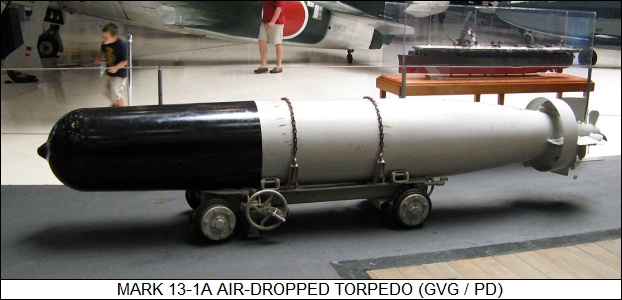
US torpedo boats also had their share of torpedo problems, but they appear to have been mostly due to the fact that at the outset of the war they were armed with very old torpedoes that weren't in good working condition. Torpedo boats ended up adopting the Mark 13, simply dropping it off the side instead of firing it from a torpedo tube. [TO BE CONTINUED]
START | PREV | NEXT | COMMENT ON ARTICLE* GIMMICKS & GADGETS: As reported by THE ECONOMIST, the revolution in natural gas production, discussed here early this year, is not only benefiting gas producers, it's also leading to growth in sales for gas power turbine manufacturers as electrical utilities turn away from dirty coal to cheap clean gas. The big four turbine manufacturers -- General Electric in the USA, Siemens of Germany, Mitsubishi Heavy Industries of Japan, and Alstrom of France -- are facing a surge of new orders.
Sales are still modest relative to those before the 2007 economic slump, and piddling compared to the huge surge in orders in 1999:2001, after widespread power brownouts across the USA led to a mad scramble by utilities to install more powerplants -- which turned out to be overreach when the dotcom bubble burst and sent the US economy downhill into a temporary spin. That sort of excessive enthusiasm isn't going to happen again, all the more so because US power regulators are prodding utilities to add renewables to their portfolio of energy sources, diverting attention from gas.
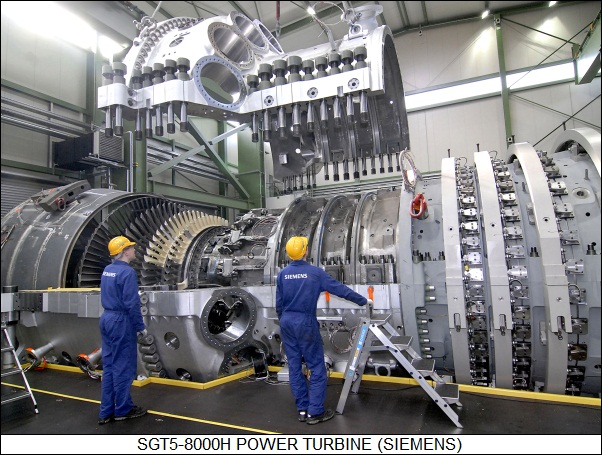
However, there's a growing market in developing countries for gas power and that translates into a long-term growth market. It also potentially translates into competition from developing nations for gas turbine manufacturers -- but they don't have to worry too much, since gas turbines are a nontrivial technology and the barriers to entry into the market are high. GE and Siemens each spent a half billion USD to develop their latest generation of turbines, and they have the kind of reputation in their field of expertise that upstarts would be hard-pressed to touch.
* As reported by BBC.com, Chinese consumer gear manufacturer Haier has demonstrated a TV that's controlled by an eye tracking system, developed by the Tobii firm of Sweden. The "Gaze TV" allows viewers to focus on icons at the top or bottom of the display to change volume, switch channels, and perform other functions.
It's strictly a prototype at the present time; it's much too expensive and doesn't perform well enough yet to be commercially introduced. The device has to be calibrated to each viewer before use and doesn't work as well if viewers wear glasses. There's no commitment to introduction of the technology, though it's clear that eye-tracking systems are poised for increasing use. While advanced user-interface technology is going to take some work to get right, it seems that it won't be too long before we have consumer gear that is so interactive that a person from a pre-technological society would think it was alive and telepathic.
* I finished my periodic cycle of proofreading the old blog archives a few months back, and so have started from the beginning, the summer of 2005, once again. It's just a quick skim of each archive now, one of the functions simply being to review old information to make connections to the present. One of the 2005 entries discussed the emergence of two-dimensional barcodes, "Quick Response (QR)" codes, placed on posters or ads scanned by cellphone users to link to a website or suchlike. According to BUSINESS WEEK QR codes have become entirely familiar to the public, with the public then simply ignoring them.
The QR code was invented in 1994 by Denso Wave of Tokyo, a subsidiary of the Toyota Group. The specific reason for doing so was to improve inventory tracking for auto parts; Denso Wave officials did think QR codes might have more applicability, and even though the technology had been patented, Denso Wave published it and allowed its use for free. QR code technology was very intriguing and advertisers embraced it, with QR codes rapidly ramping up in magazine ads -- but now they are falling off rapidly as advertisers realize that nobody pays them much mind.
QR codes could only be read by smartphone users, and smartphone users had to download an app to do so. It wasn't necessarily easy to read a QR code on a poster, harder in locations with poor lighting, and a waste of effort in, say, a subway station, where there was no wireless connection. The basic problem, however, was that consumers are passive recipients of advertising; thinking that they're going to exert themselves to seek out an advertiser's web page was unrealistic: "Why?" One user who bothers to do so said there was no great value in doing so: "About 80% of the time, I'm disappointed I scanned it. Mostly it's just curiosity at this point. I'm not actually expecting anything useful."
There's nothing inherently wrong with QR codes themselves; they're just enhanced barcodes, and we've got tremendous mileage out of barcodes. It's just a question of usage model. One interesting application of QR codes is an "electronic ticket" that can be downloaded to a cellphone, with a QR code on the phone display then scanned by a ticket reader. Denso Wave is working on a new generation of 2D scan codes, with features such as a more compact layout or support for encryption. The future, however, seems to increasingly belong to cheap near-field tags that can read, much more conveniently, by smartphones -- though no doubt the history of QR codes has given makers of near-field tags reason to be cautious in their optimism.
COMMENT ON ARTICLE* SUPER CONCRETE: The usual impression of concrete is that one sort of concrete is pretty much the same as any other, but as discussed here in 2006, there's a lot that can be done with it. As reported by THE ECONOMIST ("Smart Concrete", 3 March 2012), one thing that can be done with concrete is to make it stronger. Iranians, living in an earthquake-prone country, have an interest in tough building materials, and have developed "ultra-high performance concrete (UHPC)" formulas.
UHPC is based, like its mundane cousins, on sand and cement; but it is also doped with powdered, purified quartz, as well as various reinforcing metals and fibers. UHPC can withstand more compression than other forms of concrete. Ductal, a French UHPC, can stand up to many times the pressures of ordinary concrete. UHPC is also more flexible and durable than conventional concrete, so it can be used to make lighter and slenderer structures.
Iranian civil engineers want to use UHPC in structures ranging from dams and sewage pipes, and are working on improving it. Mahmoud Nili of Bu-Ali Sina University in Hamadan for example, is using polypropylene fibers and quartz flour, known as "fume", in his mix. It has the flexibility to absorb far heavier blows than regular concrete. Rouhollah Alizadeh, a graduate of the University of Tehran, is currently working at Ottawa University in Canada on the molecular structure of cement.
Nanoparticles are demonstrating great promise for improving UHPC. Ali Nazari and his colleagues at Islamic Azad University in Saveh have published several papers on how to do that with different types of metal-oxide nanoparticles. They have worked with oxides of iron, aluminum, zirconium, titanium and copper. At the nanoscale materials can take on extraordinary properties. Although it has been demonstrated only in small samples, it might be possible, using such nanoparticles, to produce concrete that is four times stronger than Ductal.
The published research on UHPC is focused on peaceful applications, but the material has clear military applications and defense officials in the Pentagon are worried. The USA has developed very large "deep penetration" bombs that can divot out bunkers buried deeply underground, but are they up to dealing with bunkers built of UHPC?
A study published by the University of Tehran in 2008 looked at the ability of UHPC to withstand the impact of steel projectiles -- not a major consideration in the construction of dams. The study found that concrete which contained a high proportion of long steel fibers in its structure worked best. Another study, published back in 1995, showed that although the compressive strength of concrete was enhanced only slightly by the addition 1. of polymer fibers, its impact resistance improved sevenfold.
America's Defense Threat Reduction Agency (DTRA), which has developed bunker-busting bombs, has been investigating UHPC since 2008. The DTRA's investigation has involved computer modeling and penetration testing. The agency's focus appears to be on the idea of chipping away at a target with multiple hits, but that would demand high targeting precision, and the DTRA has also considered "functional defeat" -- not blasting out the bunker but sealing its entrances, or using an electromagnetic pulse weapon to fry all the electronics. There are even ideas, like something out of a TERMINATOR movie, for using snake robots to infiltrate a bunker and then destroy it from the inside.
COMMENT ON ARTICLE* KEEP IT CLEAN: Much fuss has been made over the emergence of drug-resistant pathogens, most notably methicillin-resistant Staphylococcus aureus (MRSA). As reported by an article from SCIENTIFIC AMERICAN ("Clean Sweep" by Maryn McKenna, September 2012), sanitation measures to keep such pathogens out of hospitals are proving more troublesome than anticipated.
MRSA itself is not all that hard to deal with from a sanitation point of view. It clings to the skin, and so it could be generally dealt with by scrupulous hand-washing. However, other nasty pathogens have been acquiring drug resistance, and many of them can survive on more or less inert surfaces such as keyboards, bed rails, and privacy curtains. Hand-washing isn't enough any more.
These new threats emerged from about ten years ago. The first wave consisted of vancomycin-resistant Enterococcus (VRE) and Clostridium difficile (C. diff); the second consisted of a group of "highly-resistant gram-negative organisms", including the well-known Escherichia coli colon bacterium, as well as Klebsiella, Pseudomonas, and Acinetobacter. Acinetobacter and Pseudomonas live in the soil and are brought into a hospital on shoes and clothes -- while VRE, C. diff, E. coli, and Klebsiella live inside humans, being dispersed by diarrhea.
The gram negatives are a particular nuisance because they have a double cell wall that gives them some armor against drugs and cleaning agents. Many of these pathogens can stay alive on plastic or metal surfaces for long periods of time; a test performed by Dutch researchers showed that a sample of VRE left on such a surface still could be cultivated in a petri dish after almost four years. Samplings of hospitals show the pathogens are widespread, with one study showing that 95% of privacy curtains in a facility were contaminated by VRE or MRSA. When the curtains were replaced, 92% of them were recontaminated in a week.
Hospitals are increasingly sensitive to the issue, partly due to Federal prodding. The government's "Hospital Compare" website now publishes data on the rates of infections contracted at hospitals; in addition, from 2008 the US Centers for Medical & Medicaid Services stopped reimbursing hospitals for infections caused at a facility. That's a tough measure -- "you broke it, you fix it" -- but it does seem to be leading to lower infection rates.
Hospitals do employ infection-control specialists to track infections and nail down their causes, but the first line of defense for sanitation is the building-services crew. Not too surprisingly, hospitals have never given custodial services too much thought -- not merely due to social snobbery, but because janitors may be functionally illiterate, may not speak English as a first language, and may not stay long at their menial jobs. Janitors were traditionally seen as disposable.
A pilot project was initiated at New York University Langone Medical Center in 2010 to rethink sanitation procedures. Janitors were enlisted as critical partners in patient protection, teaming them up with infection-control specialists and nurses in five acute-care units to make sure that all high-touch surfaces remained scrupulously clean. It turned out, not all that surprisingly in hindsight, that janitors knew which surfaces were handled most often and which were most difficult to clean. After six months, an evaluation showed that associated C. diff infections were way down, as was the consumption of "last resort" antibiotics. The "clean team" approach was made standard through all the acute care units in the hospital.
Improved technology can also play a part, at least in potential, the idea being rooms that, to a degree, clean themselves. Most of the current focus is on coatings and textiles that won't support pathogens or even kill them. For example, a company named Sharklet Technologies imprints catheters with a pattern modeled on the scaly texture of sharkskin. It turns out that sharks, unlike whales, do not suffer from encrustations of algae; the Sharklet surface similarly resists colonization by pathogens.
It has also long been noted that metals such as copper and silver have antiseptic properties; apparently their ions interfere with crucial proteins in bacterial cells. Trials have shown that copper-coating high-touch surfaces in hospital rooms -- the call button, intravenous pole, bed rails, and so on -- leads to lower infection rates. Another effort has focused on yarn made of polyester impregnated with a copper-silver alloy that can be spun into a wide range of cloth items. Work on self-cleaning rooms is still in its early phases, but advocates are optimistic. However, nobody thinks that tech is going to be any more than an element in a comprehensive program of hospital sanitation: staff will still need to keep washing their hands.
COMMENT ON ARTICLE* THE DRAGON HAS CLAWS (5): An article by THE ECONOMIST's Asia blogger, Banyan, from 6 August 2012 discussed the tensions over the South China Sea. The area is effectively a box defined by China on the north, the Philippines on the east, Malaysia and Brunei on the south, and Vietnam on the west. A map of the overlapping claims to the region suggests big issues:
The sea is a valuable prize, being rich in resources -- fish, oil, gas, minerals. Tensions there have been rising in 2012, with China faced off against the Philippines and Vietnam:
There hasn't been any real armed clash since 1988 and nobody seems to be determined to have one now, but there are worries that an incident might spiral out of control.
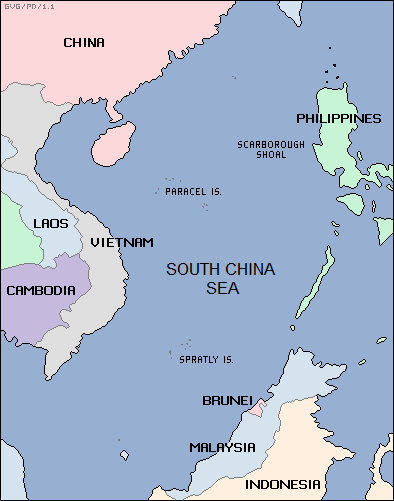
The Chinese are particularly annoyed with the Americans over the issue, seeing the USA as meddling in Asian affairs to obstruct China. In early August, the US State Department criticized the Chinese upgrading of the administrative rank of Sansha city, on one of the Paracel islands (known in China as the Xisha), from a county to a prefecture, and the establishment of a new military garrison there. In response, the Chinese Foreign Ministry summoned an American diplomat and dressed him down, expressing "strong dissatisfaction and resolute opposition" to the US statement and saying the decision was "normal and reasonable" -- though only a few hundred people live on the little islands covered by the vast new maritime prefecture.
The Chinese are entirely dubious of claims by the Americans that the USA is "neutral" on the territorial dispute -- and not without reason, since the Americans haven't shown much inclination to take Chinese claims to the area seriously. The Chinese took note of and have remembered that, at a security forum in Hanoi in 2010, US Secretary of State Hillary Clinton declared the United States had a "national interest" in the affairs of the sea, which hardly sounded like neutrality to the Chinese. The Chinese accuse the US of encouraging the Philippines and Vietnam in their confrontation of China, and of ignoring provocations by those nations against China.
The Association of South-East Asian Nations (ASEAN), the regional club to which the nations facing China around the sea belong, has tried to play a coordinating and mediating role. The Americans officially back the multilateral approach to the disputes promoted by ASEAN -- though its members are still stinging over their failure, for the first time in the organization's 45-year history, to agree on a joint statement after their annual foreign ministers' meeting, held in Phnom Penh in July. It was blocked because Cambodia, a good Chinese client, refused to accept wording on the South China Sea demanded by some ASEAN members.
The Indonesians managed to get ASEAN to agree to a bland position on the South China Sea, and China is working, if not very energetically, with ASEAN to put together a regional code of conduct to prevent fighting from breaking out. However, the Chinese insist that the territorial disputes can only be resolved through bilateral discussions with each of the states involved; the Chinese do not want everyone to gang up on them, and they particularly don't like the idea of the gang having American backing.
The Chinese see, again not without reason, that America is exploiting the disputes to enhance its position in the region, in keeping with the global "rebalancing" of the US strategic posture in favor of Asia and the Pacific. However, the Chinese are also aware of the political weakness of their position, the international perception being that China is becoming more strident and bullying in asserting its claims. The fact that Chinese claims to historical sovereignty in the South China Sea aren't all that strong, or at best no stronger than anyone else's, has helped undermine Chinese credibility on the issue. Again, nobody sees a crisis in the immediate future -- but if the pot keeps on boiling, who knows what might happen down the road?
* As a footnote, there's been a lot of anger lately in China relative to a dispute with Japan over the Diaoyu Islands, some uninhabited rocks in the East China Sea. In response, Sora Aoi -- a sexy Japanese media star with roots in the porn industry, her stage name translating as "Sky Blue" -- engaged in a bit of personal diplomacy, issuing a public call in artful calligraphy for Sino-Japanese harmony.

Sora Aoi is popular in China, with 13 million followers on Sina Weibo, China's answer to Twitter. That didn't prevent many Chinese from angrily abusing her online -- to no surprise, China's internet geeks can be as surly as those anywhere else -- but one of her admirers suggested that if China goes to war over the Diaoyu Islands, she should be captured and brought back alive. [END OF SERIES]
START | PREV | COMMENT ON ARTICLE* THE TORPEDO (13): When World War II broke out in September 1939, Germany's U-boat fleet was quick to take the offensive, and scored a number of significant victories early on. However, it was in spite of German torpedoes, which proved to have a painfully high dud rate. By the spring of 1940 the extent of the problems had become obvious, with Rear Admiral Karl Doenitz, commander of the German submarine force, pushing an effort to define and fix the problems. Analysis revealed three serious defects:
The German torpedoes were not inherently bad designs. Engineers have a saying: "If it hasn't been tested, it doesn't work." -- and weapons need to be very thoroughly tested, since they must be used in a range of environments and under adverse conditions. The fact that testing of weapons often requires the expensive destruction of realistic targets also makes them hard to qualify. Proper testing would have caught all the problems; Doenitz was aware of that fact and had the relevant officials court-martialed. However it was done, the torpedoes were made to work, much to the regret of the Allies.
* The Germans also developed homing torpedoes, with work on such technologies preceding the outbreak of war. Research faded for a time because German dictator Adolf Hitler did not anticipate a long war and knew Germany didn't have the material capability to support a long war; after the stunning German victories in Western Europe in 1940, the Germans were inclined to believe that they had effectively won, and so there was a bias against investment in new weapons over continued production of existing weapons. The delusion of a short war didn't last for very long, and work on advanced weapons was belatedly reemphasized.
Homing torpedoes were attractive not only because they could maneuver to hit a target, but because they could maneuver in the vertical plane, meaning they could hit either submarines or shallow-draft surface vessels that would be difficult to attack with unguided torpedoes. The only serious option at the outset for a homing system was acoustic -- either a passive system that could home in on target noise, or an active sonar system that could "ping" a target, providing not just direction but also range. Cramming an active sonar system into a torpedo was very troublesome at the time, and so the Germans focused on passive homing, the primary target being the noisy propellers of the target. Blowing off the propeller wasn't as likely to sink a vessel as solid hit amidships, but certainly the target wasn't going anywhere on its own after it lost it means of propulsion.
Electric torpedoes were the preferred platform, not just because such weapons had batteries to power the guidance system, but also because they were quieter than heater torpedoes -- the main issue being that a homing torpedo couldn't pick up a target that was quieter at a distance than the torpedo itself, the torpedo's noise drowning out the target noise. Ironically, it wasn't because the electric drive system was particularly quiet, since the noise was mostly generated by the propeller. The noise generated by the propeller was a function of the speed of the torpedo, and electric torpedoes were well slower than heater torpedoes.
The initial German acoustic homing torpedo, the "T4", was available in early 1943; it wasn't really ready for service, however, and quickly led to the "T5 German Naval Acoustic Torpedo (GNAT)", essentially a modification of the G7e. It never really met expectations, however, particularly once the British developed countermeasures, towing a "noisemaker" codenamed "Foxer" consisting merely of pipes clanging together behind ships to distract the torpedoes. The Germans attempted to develop a more discriminating homing seeker, this weapon being named TAUBE, but in the era of vacuum tubes it was not easy to develop particularly "smart" guidance systems. TAUBE was a failure.
The Germans devised a more ingenious wire-guided torpedo, the LERCHE, which had a hydrophone in the nose that passed back what it "heard" to an operator on the submarine, who steered the torpedo to the target. In effect, it used a human to provide the "smarts". However, from mid-1943 the German submarine fleet was on the defensive and could do nothing to regain the initiative. LERCHE was never used in combat. In addition, the Germans experimented with active homing torpedoes, in the form of the "Geier"; a scheme known as "wake homing" that tracks the turbulence of a ship's wake, and is in principle very hard to jam. They never produced a wake-homing torpedo either.
Incidentally the Germans, as well as some of the other combatants, also tinkered with "pattern-running" torpedoes during the war, which had a control system that allowed them to run straight up to a range limit, and then go in loops. The idea was that a pattern-running torpedo would be launched into a "target rich" environment like a convoy, and if it didn't score a hit, it could come back for further chances. It was tricky to get it to work in the days of mechanical control systems, and to no great surprise in hindsight, even when it could be made to work, it didn't turn out to be effective in practice. Pattern-running torpedoes were left in the dust by homing torpedoes. [TO BE CONTINUED]
START | PREV | NEXT | COMMENT ON ARTICLE* Space launches for October included:
-- 13 SEP 12 / NROL-36, SMALLSATS x 11 -- An Atlas 5 booster was launched from Vandenberg to put a secret military payload into space for the US National Reconnaissance Office (NRO). The spacecraft was designated "NROL-36" AKA "USA 238", and was believed to be a pair of signals intelligence satellites for the US Navy's "Naval Ocean Surveillance System (NOSS)", which tracks and categorizes naval targets from their radio emissions. The launch also carried 11 nanosatellite payloads, including:
-- 09 SEP 12 / SPOT 6, PROITERES -- An ISRO Polar Satellite Launch Vehicle was launched from Sriharikota on the Bay of Bengal to put the EADS Astrium "SPOT 6" Earth resource observation satellite into orbit. Spot 6 had a launch mass of 710 kilograms (1,570 pounds) and a best imaging resolution of 1.5 meters (4.9 feet). A "SPOT 7" sister satellite was under construction for launch later; the two commercial SPOT satellites were intended to complement the French government "Pleiades 1A" and "Pleiades 1B" observation satellites.
The PSLV launch also included a 10-kilogram (22-pound) nanosat from the Osaka Institute of Technology (OIT) in Japan, named the "PRoject of OIT Electric-Rocket-Engine on Small satellite (PROITERES)". As the name suggested, it carried a small electric-ion rocket engine, along with a communications test payload and an imager.
-- 17 SEP 12 / METOP B -- A Soyuz 2-1A booster was launched from Baikonur in Kazakhstan to put the ESA / EUMETSAT "MetOp B" weather satellite into near-polar Sun-synchronous orbit. MetOp B was built by EADS Astrium and had a launch mass of 4,085 kilograms (9,005 pounds). The spacecraft had a payload of eight instruments provided by the ESA, EUMETSAT, the French space agency CNES, and the US NOAA weather agency. The payloads included infrared and microwave sounders; a scatterometer; a high-resolution radiometer; an ozone mapping instrument; a space weather observation payload; plus a COSPAS-SARSAT search and rescue radio relay. MetOp B had a design lifetime of five years. It replaced the similar MetOp A, launched in 2006 and beyond its design life.
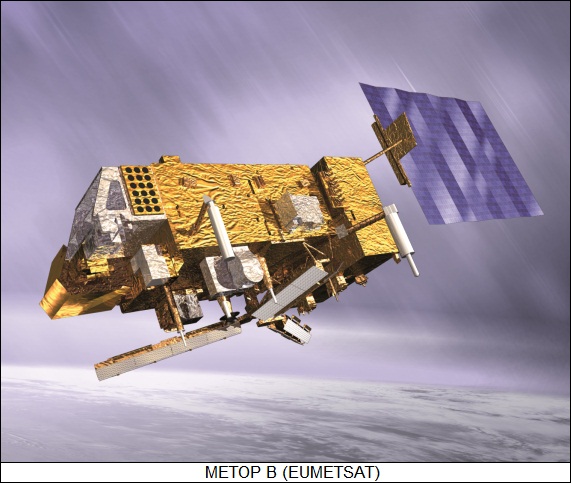
-- 18 SEP 12 / BEIDOU M5, M6 -- A Chinese Long March 3B booster was launched from Xichang to put the "Beidou M5" and "Beidou M6" medium Earth orbit navigation satellites into orbit.
-- 28 SEP 12 / ASTRA 2F, GSAT 10 -- An Ariane 5 ECA booster was launched from Kourou in French Guiana to put the SES Astra "Astra 2F" and the ISRO "GSAT 10" geostationary comsats into orbit. Astra 2F was built by EADS Astrium and was based on the Eurostar 3000 satellite platform. The satellite had a launch mass of 5,970 kilograms (13,160 pounds), a payload of 12 C-band / 6 extended C-band / 12 Ku-band transponders, and a 15-year design life. It was placed in the geostationary slot at 28.2 degrees East longitude to provide direct-to-home TV broadcast to Europe, the Middle East, and Africa.
GSAT 10 built by ISRO; it had a launch mass of 3,400 kilograms (7,497 pounds), payload of 18 C-band / 12 Ku-band transponders, and 15 year design life. The satellite also carried a secondary payload, named "GPS-Aided Geo Augmented Navigation (GAGAN)" to support air traffic in Indian airspace. It was placed in the geostationary slot at 83 degrees East longitude to provide communications services to the Indian subcontinent.
-- 29 SEP 12 / VRSS 1 -- A Chinese Long March 2D booster was launched from Jiuquan to put the first "Venezuelan Remote Sensing Satellite (VRSS 1)" AKA "Francisco Miranda" into Sun-synchronous orbit. It was built by the China Academy of Space Technology (CAST) for Venezuela and was based on the CAST 2000 spacecraft bus. It had a best imaging resolution of 2.5 meters (8.2 feet).
* OTHER SPACE NEWS: As reported by AVIATION WEEK, Elon Musk's SpaceX firm, having validated their Falcon 9 booster, is now working towards an enhanced variant, the "Falcon 9 v1.1", with first flight expected in mid-2013. It will be "stretched" from the original Falcon 9 by about 30%; will feature a wider payload fairing; and will be powered by new Merlin 1D engines, with 50% more thrust than the Merlin 1C engines they will replace. While the Merlin 1C engines on the Falcon 9 were arranged in a 3x3 pattern, the Merlin 1D engines for the Falcon 9 v1.1 will be arranged in a center / octagonal configuration, ensuring a better distribution of load onto the booster's airframe.
SpaceX has about a billion dollars worth of orders from commercial satellite operators in the queue. While such advance orders are not unusual in the airliner industry, it's unheard-of in the space industry for a firm to obtain such orders when the launcher doesn't even have a flight record yet.
* Another prominent commercial space firm, Surrey Satellite Technology LTD (SSTL) of the UK, now an EADS subsidiary, has been discussed many times in these pages. AVIATION WEEK reports that SSTL, having established itself in Earth observation through its Disaster Monitoring Constellation (DMC) optical satellites, is now working on a synthetic aperture radar (SAR) observation satellite named "NovaSAR". It will have a launch mass of 400 kilograms (880 pounds), with a SAR antenna spanning 3 x 1 meters (9.8 x 3.3 feet), and will cost about a fifth as much as existing SAR satellites.
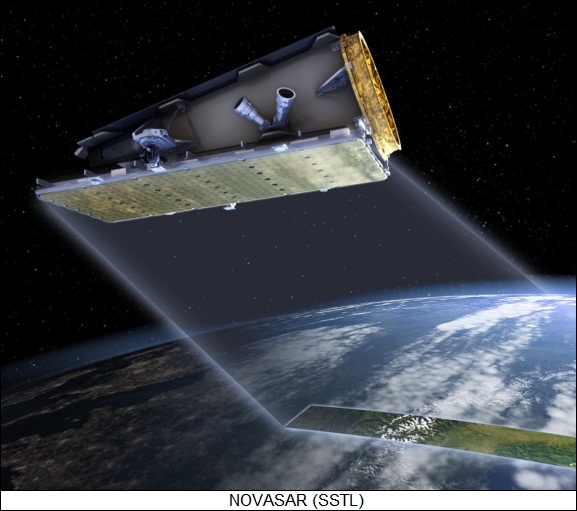
SSTL is also preparing to fly an advanced technology testbed satellite named "TechDemoSat 1 (TDS-1)", which will have eight payloads and will weigh about 150 kilograms (330 pounds). Current schedule is for launch by the end of 2012. Another project in the works is "STRaND-1", a nanosat built around a Google Nexus cellphone and the Microsoft Kinect gesture recognition system. It will be capable of agile space maneuvering and will perform dockings with the follow-on "STRaND-2". The concept behind STRaND is to experiment with composite spacecraft that use smaller spacecraft as modular "building blocks" that can rearrange themselves, with the composite spacecraft upgraded or enhanced by swapping in or adding new modules.
Over the longer run, SSTL is working on a more conventional geostationary communications satellite -- much larger than the firm's traditional offerings, with a launch mass of about 2,500 kilograms (5,510 pounds) and with a solar array providing 4.5 kilowatts. While big by SSTL standards, it will be small by comsat standards, and is intended to complement EADS Astrium's standard Eurostar 3000 comsat bus. No doubt SSTL is designing their comsat with an eye towards potential adaptation to other spacecraft; the firm is not one to miss an obvious trick.
COMMENT ON ARTICLE* COLLECTIVE MEMORY: Ants are noted for the often surprisingly elaborate behaviors of their nest collectives. As reported by an article from the ABC.au site ("Weaver Ants Use Corporate Memory To Defend Nests" by Rachel Sullivan, 12 March 2012) the behavior of collectives of "weaver ants" demonstrates a degree of collective memory.
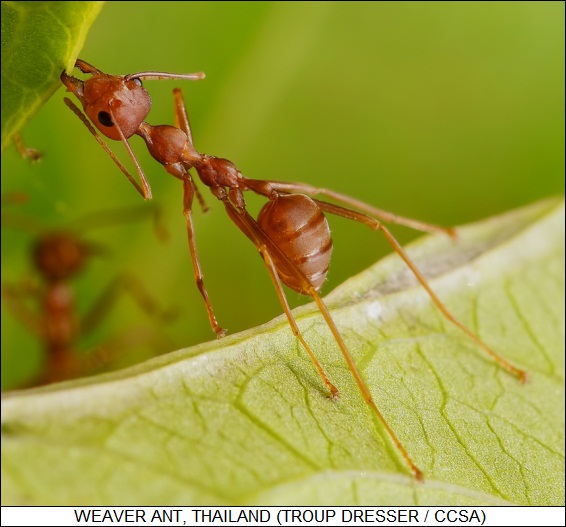
Weaver ants are tropical insects that live in the treetops, weaving together nests of leaves using silk. They are found in northern Australia, Southeast Asia, India and Africa. Also known as green ants, green tree ants and orange gasters, they can be orange or green. University of Melbourne researchers investigated the weaver ant Oecophylla smaragdina, with one of the researchers, Dr. Mark Elgar, commenting:
BEGIN QUOTE:
Arboreal weaver ants are "polydomous", with several leaf nests making up a single colony of up to a million closely-related members. They exhibit highly coordinated responses to intruders, defending their colonies from enemies that include other ants from the same species.
Workers that leave the nest to forage are far more likely to encounter rivals from other colonies, but we wanted to know how a worker that typically remains inside the nest tending the brood discerns whether an ant it has never seen before is a member of its own colony or a rival that should be met with aggression.
END QUOTE
Ants are known to be very smell-oriented, identifying unwanted intruders from other ant colonies by their aroma. Through observations of ants from twelve distinct weaver ant colonies, the Australian researchers found that ants who encounter ants from rival nests were able to pass the aroma of intruders on to other ants. Ants also were able to remember which intruders were bigger threats, responding more aggressively to intruders with a history of incursions.

The researchers weren't entirely certain how the "news" about intruders was passed on. In some cases dead rivals were taken back to a nest and passed around, but that wasn't true in all cases, and the researchers are now working to find out other mechanisms.
* The ABC article linked to an article from the website from 2 February 2011 ("Ant Genome May Reveal Survival Secrets") that discussed the decoding of the genome of the Argentine ant, which has spread from its South American home to become a nuisance in warm climates all around the globe. As noted above, ants are highly smell-oriented, and the genomic study confirmed that fact: Argentine ants have an extraordinary 367 sensory receptors for odor and 116 for taste, more than double the honeybee's capacity for smell and well above the mosquito's 76 taste receptors.
Argentine ants also appear to have adapted to the variety of poisons they may encounter in their diet by developing a large number of "cytochrome P450" genes, important in detoxifying harmful substances. Argentine ants have 111 such genes, while European honeybees, in comparison, have 46.
COMMENT ON ARTICLE* DISABILITY AS A BUSINESS OPPORTUNITY: As discussed in an article from THE ECONOMIST ("The New Green", 8 September 2012), the London Paralympics -- the Olympics for the disabled, discussed here in August -- ended on 9 September, having proven a smash. Tickets were sold out and ratings on UK Channel 4, which broadcast the event, were high. Broadcasts were also popular in China, whose athletes absolutely cleaned up on medals, and Western Europe, though the Paralympics were stiffed by broadcasters in Russia, Japan, and the USA.

The London Paralympics have done much to highlight changing attitudes towards disabilities -- though activists for the disabled wonder if now they're not shifting towards an expectation that disabled should all become star athletes. More pragmatically, however, there has been a shift towards seeing the disabled as a business opportunity.
Sainsbury's, the UK's high-end supermarket chain, found its prominent sponsorship of the Paralympics paying off nicely, giving the firm considerable public recognition and making the investment of advertising dollars a bargain. However, that's a superficial aspect of the business case, a more significant one being that the disabled represent a substantial workforce, and in an era when facilities are designed for access by the disabled as a normal practice, there may be little penalty in hiring them on.
Kanchi -- an Ireland-based disability advocate organization founded by one Caroline Casey in 2000 -- has led the way in promoting work for the disabled, handing out "Ability Awards" to companies with a focus on aiding the disabled. After becoming established in Ireland, Kanchi then moved into Spain, where the organization hooked up with Spanish telecoms giant Telefonica. With Telefonica backing, Kanchi is reaching out to even more countries, including Britain, Germany, and Brazil. Jorge Perez of Manpower, an employment-services firm, says that disabled people can have surprisingly high productivity. Autistic people, for one example, can focus on repetitive tasks that would bore others. Britain's electronic intelligence spy center, GCHQ, is quick to recruit people with autism and Asperger's syndrome, finding they often make excellent codebreakers.
The other bottom line to the disabled is that they represent a substantial market opportunity. While in the employ of Merrill Lynch, Rich Donovan -- who has cerebral palsy -- realized just how many disabled there are. If only 1 in 50 of the world's population could be judged disabled, and that's a conservative estimate, that would still be well over a hundred million people. Donovan notes that a generation of people who have been assisted by disability laws are now entering the workplace, while disabilities are increasing among the aging baby boomers. In both cases, these folk are not impoverished, and companies able to serve their needs can make profits.
Unfortunately, Donovan's analysis of disability awareness at Fortune 500 firms showed that only a quarter of them had a strategy aimed at the disabled, and only 6% were doing any real business with them. Donovan's pushing for change; and given signs such as the public success of the London Paralympics, it's not too much to hope that change really is coming.
COMMENT ON ARTICLE* THE DRAGON HAS CLAWS (4): As discussed here last year, of course China's neighbors are particularly worried about Chinese power projection, as well as America's ability to meet that challenge. President Obama's stated strategy of "rebalancing" is intended to help calm those doubts, though nations in China's shadow will have to develop their own counterforce capabilities as well. Even if Chinese defense spending doesn't continue its "long march" upward, America has global responsibilities while China is still focused on regional actions; China can create a local preponderance of force that the US would be hard-pressed to match.
However, for all the concerns, few see China as hell-bent on world domination. China is doing global business in support of national economic development, and so has a vested interest in maintaining the stability of the global economic system. That places a limit, if an elastic one, on how far China is willing to go in upsetting the strategic applecart. The other side of that coin is that Chinese military spending is dependent on economic development; growth in defense spending only reflects growth in the economy, not an effort to promote military might at the expense of everything else. It provides a useful corrective to fears about Chinese military power to realize that over the past number of years, China has spent a roughly constant proportion of GDP on defense -- a little over 2%, while America spends about 4.7%. That also means that the growth in Chinese military capability is likely to slow down if the economy does, and nobody expects Chinese economic growth to continue at a rapid clip forever.
Besides, the Chinese have long borders to defend; for now, none of its neighbors represent a real threat, but the leadership can't assume they won't be a problem in the future. Much more significant are internal threats in the present: China is an authoritarian state on the model of a one-party oligarchy, inclined to the repressive, attempting to maintain control over a vast nation with significant ethnic divisions. To gauge the significance of this reality, in 2011 spending on internal security outstripped military spending for the first time.
Those same divisive pressures are also reflected in the need to balance guns and butter -- the butter being greater prosperity, better government services for Chinese citizens, improvements in public infrastructure, getting China's nasty environmental problems under control, and caring for a graying population. The Communist Party knows that if it doesn't do a good job of running the country, it will lose the "mandate of heaven" and its right to rule. China's past is marked by the rise and fall of imperial regimes, and the leadership is perfectly aware that they could end up on the trashheap of history along with all of China's extinct regimes.
Another factor in the consideration of Chinese military development is the fact that China was once the great power of the world, and once again is a world power. It is easily expected that China will want to have a military force matching the Chinese perception of their own international importance. Some practical American policy makers see that urge as perfectly natural, and if China presents an implied threat by doing so -- well, that's just life on the global chess board.
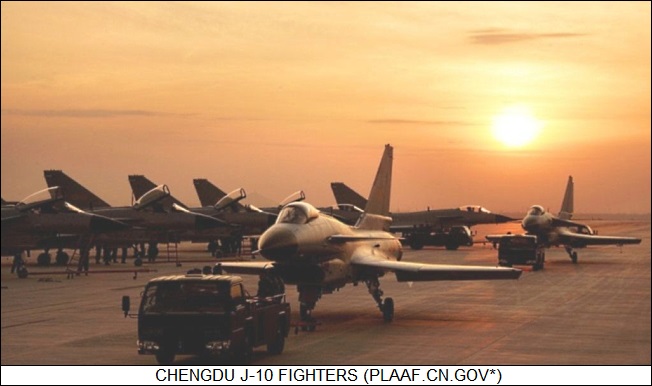
In fact, the West is occasionally schizophrenic about Chinese power, fussing about it and then asking China to accept greater responsibility for global order, much to the exasperation of the Chinese. General Yao Yunzhu of the Academy of Military Science commented: "We are criticized if we do more and criticized if we do less. The West should decide what it wants. The international military order is US-led NATO and Asian bilateral alliances. There is nothing [in military terms] like the WTO for China to get into."
Finally, the PLA may be a paper dragon, and the Chinese know it. Although it has made great advances, China still lags the West in most categories of miltech development. The Chinese have done a lot of copying, which gives them a leg up in weapon systems development, but it also leaves them stuck behind the leading edge. There's suspicion that the Chinese are heavily involved in cyberhacking to penetrate Western defense contractors and obtain information on the latest miltech. Many of China's most advanced weapons are Russian-built, or manufactured in China under license from Russia; some Russian weapons are excellent, but the Chinese are also perfectly aware the Russians are cheerfully selling the same weapons to Vietnam and India. Indeed, Russian-Indian cooperation in miltech development is so close that to an extent improved Russian weapons tech is being funded by India.
The PLA also has painfully little combat experience. China fought the Americans to a standstill in Korea, if at considerable expense in casualties, but the last time the PLA fought something resembling a real war was in 1979, when China invaded Vietnam -- a campaign that didn't go well for China, the Vietnamese being both battle-hardened and well-prepared. In contrast to the PLA, US forces have been engaged in running fights over the past decades, and their professionalism is in a high state. With the new American strategic plan to focus on Asia, the Americans are busily considering what they need to do to neutralize or get a jump on China's asymmetric threats, for example improving the ability to jam or shoot down Chinese missiles -- and American defense cutbacks may actually help doing so by focusing spending on technologies and tactics that provide the most return to that end, instead of pumping development funds into gold-plated superweapons.
The Chinese clearly have doubts they can adequately handle the sort of complex and difficult joint operations the Americans have become increasingly well-practiced in. General Yao says the gap between American and Chinese forces is "at least 30, maybe 50, years". She adds, possibly optimistically: "China has no need to be a military peer of the US. But perhaps by the time we do become a peer competitor, the leadership of both countries will have the wisdom to deal with the problem." [TO BE CONTINUED]
START | PREV | NEXT | COMMENT ON ARTICLE* THE TORPEDO (12): As the submarine came into its own in the first decade of the 20th century, the torpedo matured as well. The German Navy obtained a 50-centimeter (19.7-inch) "Type G" torpedo in 1906, with a 200-kilogram (440-pound) warhead, a speed of 67 KPH (41 MPH / 36 KT), and a range of 6,000 meters (6,560 yards). It was a direct evolution of Schwartzkopff torpedo designs.
The Royal Gun Factory in Britain introduced a 21-Inch (53-centimeter) torpedo in 1908, while the Weymouth factory -- by that time, divested as a separate business entity from the Whitehead organization in Fiume -- introduced a weapon of the same diameter in 1909. These initial variants proved disappointing, but they were followed by refined variants that worked out the bugs. In fact, 21 inches would prove to be more or less the standard torpedo diameter for the rest of the century. The Whitehead firm also built 61-centimeter (24-inch) torpedoes for the Japanese, which were used for shore defense. This prewar generation of torpedoes not only featured heater propulsion systems and gyroscopic control, they also replaced the guncotton warhead with a more potent TNT warhead.
With the beginning of the First World War in 1914, the torpedo finally proved just how devastating a weapon it could be, with German U-boats -- submarines -- coming close to strangling the British Isles, sinking hundreds of Allied vessels with the excellent Type G 50-centimeter torpedo, though the older and smaller 45-centimeter (17.7-inch) torpedo also saw some use. Germany, not being a maritime power, was less vulnerable to submarine attacks, but British submarines scored their "kills" with 18-Inch and, eventually, 21-Inch torpedoes, with the 21-Inch torpedo becoming a preferred weapon. However, a submarine could only carry a relatively small load of torpedoes, and so submarine captains preferred to sink small vessels with a deck gun whenever possible.
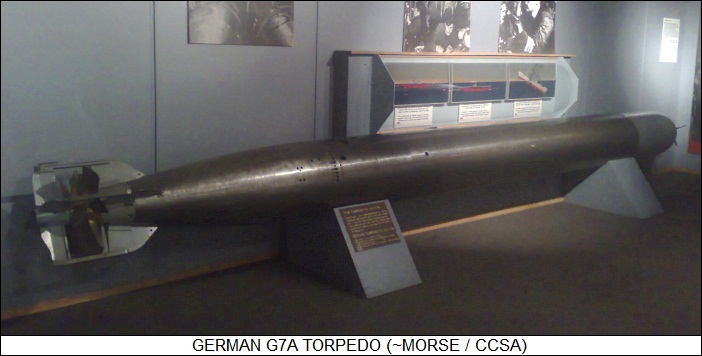
The British -- and to an extent their allies the Italians -- also began to experiment with dropping the torpedo from aircraft, supposedly the first live drop in history being performed by a Shorts seaplane on 28 July 1914, a week before the war broke out. During 1915, the Royal Navy performed torpedo attacks against Turkish vessels using Shorts 184 seaplanes carrying old (14-Inch) 35.6-centimeter torpedoes, with mixed results. The British also obtained uprated Shorts seaplanes capable of carrying 18-Inch torpedoes, but the air-dropped torpedo remained a curiosity during the First World War.
Although the torpedo was a highly refined and effective weapon during World War I, following the conflict there was work on further improvements, particularly to enhance range. One ploy was to replace ordinary air in the pressure vessel with a more enriched "oxidizer", such as straight oxygen or hydrogen peroxide, which broke down in a heater engine into oxygen and water. The British carried out tests with hydrogen peroxide, but oxygen / hydrogen peroxide torpedoes proved dangerously tricky. From the late 1920s, the British turned their attention to the Brotherhood Company's "Burner Cycle" engine, an improved four-cylinder radial featuring fuel injection of kerosene or shale oil atomized in a compressed-air flow. The Burner Cycle engine would ultimately be able to propel a torpedo over long range at speeds of up to 92 KPH (57 MPH / 50 KT).
The Japanese persevered with oxygen torpedoes, introducing the 61-centimeter (24-inch) "Type 93" in the mid-1930s. It carried a 500 kilogram (1,100 pound) warhead up to 40 kilometers (25 MI / 22 NMI) at 67 KPH (42 MPH / 36 KT), with a bit better than half that range at 90 KPH (56 MPH / 49 KT). It did not leave a wake, its exhaust dissolving in the water instead of forming bubbles. The Type 93 was strictly surface-launched, though the Japanese would later develop from the Type 93 a 53-centimeter (21-inch) "Type 95" and ultimately a 46-centimeter (18-inch) "Type 98" for submarine use.
In the meantime, the Germans were working on electric torpedoes, powered by batteries driving an electric motor instead of traditional mechanical propulsion. Torpedoes had been traditionally difficult to build, mostly because of the challenge of their propulsion systems; an electric torpedo promised to be much less troublesome and cheaper to build. By the 1930s the Germans had developed the "G7e" electric torpedo, externally similar to the more traditional "G7a" heater torpedo. The G7e's speed and range were inferior to that of heater torpedoes, but it was much easier to produce in quantity -- and it also did not leave a wake.
A number of nations also worked on improved detonator systems, most significantly the "magnetic exploder". The idea was that a torpedo would be depth set to run underneath a target vessel and then be detonated by its magnetic influence, holing it in the bottom where damage would be the hardest to deal with. It was an appealing idea, but it would prove tricky in practice. [TO BE CONTINUED]
START | PREV | NEXT | COMMENT ON ARTICLE* SCIENCE NOTES: As something of a follow-on to the series on metagenomics run here earlier this year, SCIENCEMAG.org reported on the voyage of the TARA, a sailing research schooner that returned to port in Lorient, France, at the end of March after a year's cruise around the world's oceans. The "TARA Oceans" mission was focused on samplings of oceanic plankton -- loosely defined as every possible small oceanic organism, including fish larva, small multicellular animals, protists, bacteria, archaea, and (stretching the definition of "organism") viruses. The crew of the TARA obtained tens of thousands of samples collected at 153 spots, from the Mediterranean Sea and the Red Sea to the Pacific Ocean and the Antarctic, with samples taken at each locale from from the water surface to almost 1 kilometer deep.
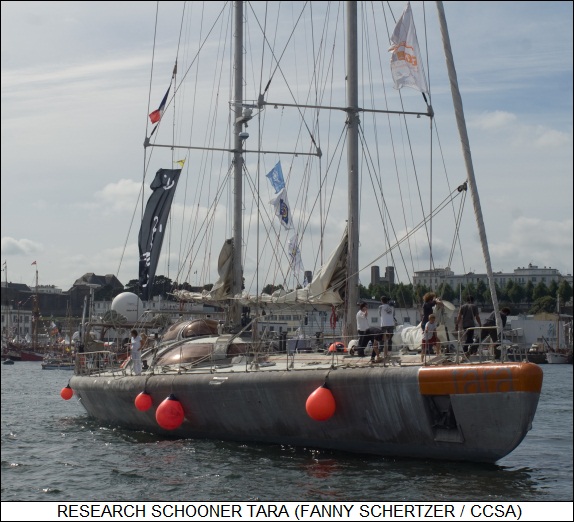
Half of the samples were taken for morphology studies. Using filters with different mesh sizes, researchers separated the organisms according to size, from tiny viruses to zooplankton, and then used automated imaging systems to classify them. The other half of the samples were used for molecular biology studies, with metagenomic analysis revealing at least 1.5 million distinct taxa of organisms. Broad metagenomic scans aren't good at nailing down distinct organisms, but clearly most of the organisms were unknown, the the great majority of genes discovered coding for proteins never seen before.
Preliminary results suggest that the smaller the organisms, the more abundant they are -- not just in numbers, which isn't surprising, but in diversity, viral diversity proving a great surprise. Diversity varied considerably between different locations, being dependent on factors such as ocean streams, temperature, depth, and acidity. There were also distinctive correlations between different plankton kingdoms in different regions: archaea and bacteria prefer living together, as do bacteria and viruses, but archaea don't seem to get along at all with viruses and protists. The research team intends to take the TARA to the Arctic in 2013 for a follow-on study.
* As reported by THE NEW YORK TIMES, the University of California at Davis has now set up a new public genomic database, with a goal of cataloging the genomes of 100,000 strains of bacteria found in food. Such a database would be highly valuable in tracing food-borne illness. The database will list bacterial genomes, along with the food associated with the particular bacterium, and the country of origin.
The US Centers for Disease Control and Prevention has a large bacterial database that covers food-borne pathogens, but it's not complete or detailed enough to make it easy to trace a pathogen to food or country of origin. Building a catalog that can is not easy -- the well-known Salmonella bacterium alone having about 2,500 strains, almost three times as many as all the sequences for food-borne bacteria that have been cataloged to date. With improved genomic analysis tools, however, the organizers of the UC Davis database hope to have it loaded up by 2017.
* As reported by BBC.com, a team of US researchers led by Brian Fisher of the California Academy of Sciences is now canvassing the world to obtain highly-detailed, all-round imagery of ants in various museum collections. The images are described as "3D" in the sense that a viewer can rotate them and give them as close an inspection as desired. Says Fisher: "You can zoom in and see fine hairs, the eyes, all of this detail. And all of this, under a microscope, is not in focus."
Although no mention was made of it, clearly such comprehensive imagery could in principle also be rendered in stereovision with the proper viewer system. In any case, the images will be placed in an online catalog named "Antweb" for general research use. The team has already covered the US, having obtained images of 8,000 ant species, and is now investigating ant collections abroad. Fisher comments: "Our goal is to image 10,000 a year."
At last report, the team was canvassing the Natural History Museum in London, where they imaged more than 6,000 specimens. For the database to be complete, the team must take several images of each species, including examples of all the different ant castes -- queens, soldiers, minor workers -- and the different sexes. Fisher says: "This project will mean that anybody, anywhere at any time will have access to these specimens that we hide in museums."
COMMENT ON ARTICLE* NEW MOON? The traditional notion of the origin of the Earth's Moon was that the Earth collided with a hypothetical, Mars-sized planet named "Theia" early in its existence, and the resulting smash-up produced a disk of magma orbiting our planet that later coalesced to form the moon. This is known as the "giant impact" hypothesis. As reported by an article from SCIENCEMAG.org ("Findings Cast Doubt on Moon Origins" by Tim Wogan, 25 March 2012), a new study is calling that scenario into question.
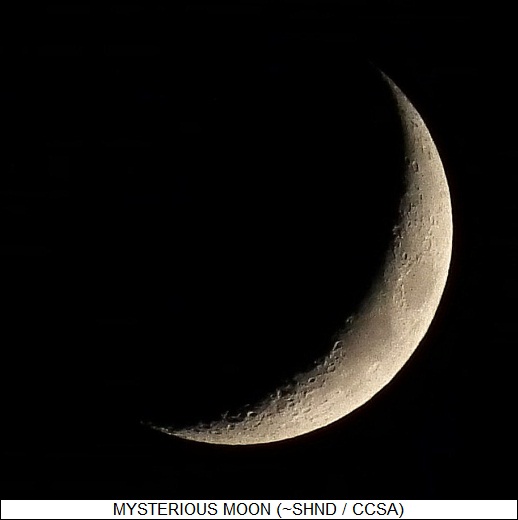
Computer models of the giant impact show that at least 40% of the magma would have had to come from Theia. One way to test the hypothesis is measure the isotopes of particular elements in rocks returned from the Moon by the Apollo missions. Oxygen, for example, has three isotopes, including 016, 017, and 018, and samples of Earth minerals will as a good bet show pretty much the same ratios of these isotopes. The ratios found in meteorites from other planets such as Mars, however, have distinctly different ratios.
Earlier research has shown that the oxygen isotope composition of Moon rocks is the same as that of Earth rocks. That's actually a bit puzzling, because there's much more of Theia in the Moon than there is in the Earth, and that should have resulted in a different isotope ratio.
Various ideas have been floated to account for the non-discrepancy, but a paper by a team of geochemists from the US and Switzerland performed an isotopic analysis of the ratios of titanium isotopes -- Ti47 and Ti50 -- in Earth and Moon rocks, and found a match there as well. None of the schemes cooked up to explain away the oxygen isotope non-discrepancy work for titanium. This finding helps to promote a long-standing alternate concept of the origin of the Moon, that it arose by fission from the proto-Earth. In that scenario, the matching isotope ratios would make perfect sense.
However, the fission scenario has long been out of favor because nobody has any convincing idea of how it could have happened. An impact of a body big enough to cause the split leads right back to the giant impact hypothesis. A glancing blow by a large body against the proto-Earth, with the intruder then continuing off into space generally intact, might have "spun up" the proto-Earth to such a rapid rotation rate that it split -- but then what happened to the angular momentum?
Planetologist Matthias Meier of Lund University in Sweden, who was not involved in the new study, finds the research persuasive, but he's not ready to give up on the giant impact hypothesis: "I think the general idea of having an impact forming a disk and this disk then forming a moon is probably right, but this paper shows us that we still don't understand exactly what the mechanism is, and there is a lot of work to be done in that field."
COMMENT ON ARTICLE* BRAND NAME REVOLUTIONS: As reported by an article from THE ECONOMIST ("Brand New", 4 August 2012), emerging economies are starting to make a global impact with increasing recognition of new product brands. One significant example is Chinese computer-maker Lenovo, founded in 1984 by eleven engineers at the Chinese Academy of Sciences who wanted to supplement their modest pay as researchers. After over two decades of gradually building up business, Lenovo burst onto the global scene in 2005 when it bought IBM's ThinkPad personal-computer operation. The company is now the second-largest PC maker in the world, and hopes to grab the top spot from Hewlett-Packard soon. Lenovo recently announced a deal to sponsor the US National Football League -- an interesting combination of Chinese brains and American brawn.
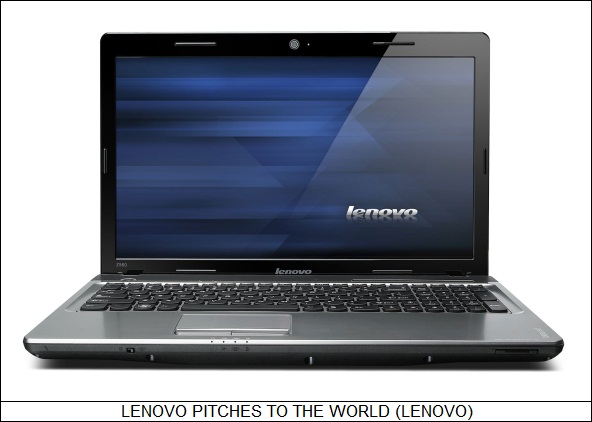
Once an emerging-market firm reaches a certain critical mass, it has a very strong incentive to acquire global brand recognition: non-branded companies typically earn gross margins of 3% to 8% and are always at risk of being undercut by cheaper rivals, while branded firms have fatter margins, 15% or better, and loyal customers.
However, achieving such recognition is expensive and the barriers to success are high. It's a chicken & egg problem: in places such as the USA, Chinese and Indian firms have little brand recognition, and so consumers won't buy their products. A consumer-research survey found that only a third of Americans would even consider buying a Chinese or Indian car. In fact, only four emerging-market brands are in the top 100 list of global brands at present: Samsung and Hyundai of South Korea, Mexico's Corona beer, and Taiwan's HTC.
The book THE NEW EMERGING-MARKET MULTINATIONALS, by business scholars Amitava Chattopadhyay and Rajeev Batra, suggests rules for regional businesses aspiring to be global players:
Brand-building is tough; it can take decades of work and investment to pay off. The fastest way to build brand recognition is to buy out an existing brand, but that can be trickier than it looks -- as Lenovo discovered after buying out IBM's ThinkPad, and Tata Motors found out after buying out Jaguar. Juggling a portfolio of brands can be very tricky, sometimes too tricky for company bosses who got their start by coming up with good products, to then manufacture and sell them. Selling a brand name, in contrast, is all about image building; there has to be some substance there, of course, but recognition is basically about style.
Still, it's apparent that in ten or twenty years, consumers are going to be faced with a truly global range of product offerings. Even now, HTC makes some of the hottest-selling smartphones in America. Huawei, a Chinese firm, has just overtaken Sweden's Ericsson to become the world's largest maker of telecommunications equipment. It's all happened before, back in the 1960s and 1970s, when Japanese firms broke out on the world scene. The same history is now repeating itself -- on a much larger scale.
[ED: I'm old enough, if just barely, to remember the time when "Made In Japan" meant "junk", and the startling transition to the era when it didn't. Japanese competition gave American manufacturers a shock they've never completely recovered from -- but it could have been predicted. The Second World War had wrecked all the world's major powers except the USA, and sooner or later the others were going to rebuild and become competitive again.
As for myself, I'm enthusiastic about more international competition. This has nothing to do with being a "global citizen"; I just want more product offerings at the lowest price. Sure, I prefer to "buy American" if I can, but no sensible consumer or manufacturer forgets the Iron Law of business: the customer is always right. This is a fact, not in the sense that customers necessarily have a clue -- but in the sense that if they don't like a product, they simply won't buy it, and there's nothing that can be said.]
COMMENT ON ARTICLE* THE DRAGON HAS CLAWS (3): In 2010, the US CSBA identified the core military assets China is likely to have on hand by 2020, the list including:
In addition, the PLA Navy is faced with the decision to become organized around aircraft carriers. China recently inaugurated its first operational carrier, a refurbishment of a Russian carrier, though it's only mission is test, training and, it seems, propaganda. Actually committing to operational use of aircraft carriers is a different matter, since they are very expensive to build and operate.
Carriers are only worth the money if China is really interested in "power projection" on the high seas and to foreign shores. For national defense, missiles and long-range shore-based aircraft would provide China with all the necessary capability at much lower cost. China may have a fleet of small carriers by 2020 as well, but it would probably take much longer to develop naval doctrines to make proper use of them. For the most part, however, the PLA of 2020 will be "asymmetric", not intended to meet US power head-on but to instead exploit its weaknesses, and it's hard to see how aircraft carriers fit into that picture.
One part of the picture that is entirely clear is Taiwan, the key concern for China's military modernization. In 1996 the US reacted to Chinese ballistic-missile tests carried out near Taiwanese ports by sending two aircraft carrier groups into the Taiwan Strait. The Chinese backed up immediately, but instead of concluding they shouldn't try it again, they decided to make sure that things would be different the next time around. Since 2002 China's strategy has been largely built around the possibility of a cross-Strait armed conflict in which China's forces would not only have to overcome opposition from Taiwan but also to deter, delay, or defeat US intervention. By 2020, China is very likely to have a force that can make things very difficult for or even defeat US naval operations in East Asia.
The Chinese make no secret of the significance of Taiwan in their thinking. In 2005 China passed the Taiwan Anti-Secession Law, which commits China to a military response should Taiwan ever declare independence, or even if the Chinese government unilaterally decides that peaceful unification is impossible. Jia Xiudong of the China Institute of International Studies, the Foreign Ministry's main think-tank, said bluntly:
BEGIN QUOTE:
The first priority is Taiwan. The mainland is patient, but independence is not the future for Taiwan. China's military forces should be ready to repel any force of intervention. The US likes to maintain what it calls "strategic ambiguity" over what it would do in the event of a conflict arising from secession. We don't have any ambiguity. We will use whatever means we have to prevent it happening.
END QUOTE
Chinese military planning has other concerns as well. In 2004 Chinese President Hu Jintao said the PLA should be able to undertake "new historic missions". Some of these involve UN peacekeeping; in recent years, China has been the biggest contributor of peacekeeping troops among the permanent five members of the Security Council. However, power projection is also an element of these "new historic missions", with the PLA Navy shouldering most of the responsibility for that job. The PLA Navy appears to see itself as the guardian of China's ever-expanding economic interests, with missions including:
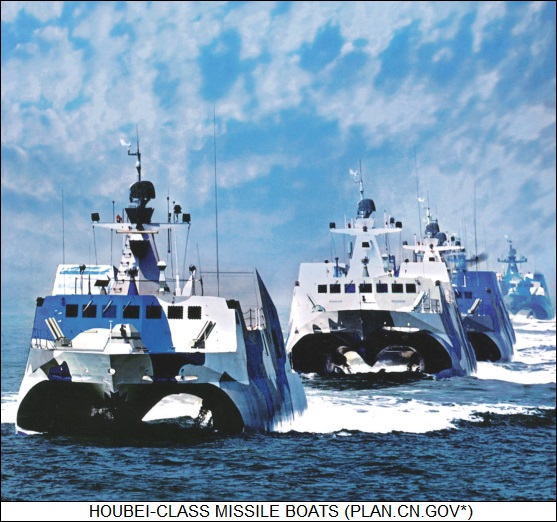
The PLA Navy's growing fleet of powerful destroyers, stealthy frigates and guided-missile-carrying catamarans allows it to extend its traditional coastal role to regional "green water" operations, and also reach further into global "blue water" operations as well. In early 2009, the navy began anti-piracy patrols off the Gulf of Aden with three ships. Last year, one of those vessels was sent to the Mediterranean to help evacuate 35,000 Chinese workers from Libya -- an impressive exercise in logistics, carried out by the PLA Air Force. [TO BE CONTINUED]
START | PREV | NEXT | COMMENT ON ARTICLE* THE TORPEDO (11): The first really serious use of the torpedo in combat took place during the Russo-Japanese War. Russian intrigues in Korea and Manchuria had antagonized the Japanese, and they finally decided on war with the Russians. They didn't telegraph their intent, however, the scheme being that they would strike the Russians simultaneously with a declaration of war, in particular launching torpedo boat attacks on the Russian fleet at Port Arthur, the northern gate of the Yellow Sea.
The strike, using ten torpedo boats, took place on the night of 8:9 February 1904. It was not as successful as hoped, with 19 Whiteheads launched but only three finding their targets, and none of the three ships hit sank. However, the attack was enough to throw the Russian fleet on the defensive -- though that also meant the Russians improved their defenses. A series of torpedo-boat raids against Port Arthur in December 1904 led to the expenditure of 150 torpedoes, with only four hits and the loss of two torpedo boats.
The war was effectively resolved on 27 May 1905, when Japanese Admiral Togo inflicted a staggering defeat in the Straits of Tsushima on a Russian fleet sent to reinforce the defense. The battle was resolved by naval gunnery, but Japanese torpedo boats were sent in to finish off surviving but injured Russian warships, with nine of them sent to the bottom for the loss of three torpedo boats. The Russians were no longer able to continue the war with any chance of success, but they wouldn't give up, and the conflict was straining Japanese resources to the limit. American President Teddy Roosevelt helped the two sides negotiate a settlement, leading to the signing of the Treaty of Portsmouth in August 1905.
The performance of the torpedo in the conflict was mixed, with critics of the weapon claiming events had justified their skepticism. Advocates claimed the Japanese had been inept, and in fact the torpedo being a new weapon, nobody was particularly skilled in its use. In any case, navies lost little of their enthusiasm for the torpedo, particularly since they were beginning to deploy a new launch platform for which the torpedo was almost uniquely suited: the submarine.
By the late 19th century, the submarine had progressed by increments from suicide boats like the Confederate HUNLEY, finally leading to practical weapons. While there were many contributors to submarine design, the work of Irish-American inventor John Holland stands in the history of submarine technology as a watershed, the first operational submarine fleets being based on the Holland pattern. The US Navy purchased his HOLLAND VI in 1900, naming it simply the USS HOLLAND, leading quickly to acquisition of HOLLAND VII submarines. The Royal Navy and other naval forces quickly acquired Holland submarines of their own -- even the Whitehead works in Fiume built Holland-pattern submarines for the Austrian Navy -- and by 1905, the basic configuration of the modern submarine had been established.
Although Holland had tinkered with a number of different armament options along the way, he ultimately settled on the torpedo. While submarines would mount deck guns for half a century, they were limited in that the submarine had to surface to make use of them. In contrast the torpedo, as an underwater weapon, was ideally suited to an underwater launch platform. Indeed, without the torpedo the prospects for the submarine as a weapon would have been much dimmer. [TO BE CONTINUED]
START | PREV | NEXT | COMMENT ON ARTICLE* GIMMICKS & GADGETS: As reported by WIRED.com, LED lighting is catching on everywhere, even in orbit. Astronauts living in the International Space Station (ISS) tend to have trouble getting a good night's sleep because they don't have a 24-hour lighting cycle, instead going from day to night to day every 90 minutes. When the US National Aeronautics & Space Administration (NASA) decided to replace the existing fluorescent lighting on the ISS with LED lamps, the agency talked to sleep specialists -- notably neuroscientist George C. Brainard of Thomas Jefferson University in Philadelphia, Pennsylvania -- to see if LED lighting could help with the sleep problem.
Brainard already knew that a certain tone of blue light could be used to suppress melatonin levels in the body, melatonin being the hormone responsible for regulating the sleep cycle. He performed experiments on volunteers living in closed quarters with different lighting conditions, then measuring their melatonin levels. Straight colored lights can't be used on the ISS since astronauts need to be able to properly recognize colors when working on the station, for example to tell a white wire from a blue wire. As a result, the LEDs will generate white light with subtle color tones. When the astronauts wake up, the light will turn brighter with cool blue tones and in the evening, warmer with heavier red tones.
NASA is working with Boeing to implement the lighting scheme, Boeing having used something roughly along the same lines with the LED lighting on the 787 jetliner, as discussed here in 2010. The new lighting scheme will be installed on the ISS from 2015. It's interesting to wonder if we'll have cyclically-adjusted LED lamps for home use a few years down the road, with a lamp fixture featuring a built-in clock to set the proper lighting for the time of day. Of course the fixture will probably also need a wireless interface to program the lighting -- which sounds absurd, but in ten years it may be perfectly normal for cheap appliances to have wireless links.
* I got a tipoff to a gimmick being pushed on the Kickstarter crowd-sourcing site, a little computer named "Ubi", for "ubiquitous". The Ubi is just a handy-sized "brick" that plugs directly into a wall socket; it runs the Android OS, has an ARM CPU, a gigabyte of RAM, microphone plus speakers, wi-fi / Bluetooth / USB interfaces, and environmental sensors. The idea is that the Ubi will keep track of the household environment and respond to voice commands to, say, tell it to access music from a server, or fetch data and present it via voice synthesis, or transfer voice messages, and so on.
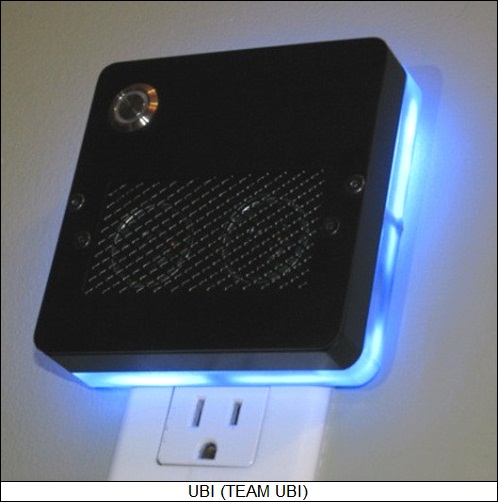
Price is to be under $150 USD in single units. Ubi is yet another idea that might just be a silly gimmick, but seems to have potential, and could be universal in a generation: "Play some ambient music, Ubi." "I'm sorry Dave, I can't do that." [ED: As of 2019, the Ubi never amounted to much in itself, but "smart speakers" like the Amazon Echo have conquered the world.]
* In another Kickstarter initiative, a startup named Milkshake Labs is offering the "coco controller" for people who want more serious gameplay on their iPhone or Samsung Galaxy SIII smartphone. All the coco controller amounts to is a snap-over case for a smartphone, with the case providing a directional pad, a joystick, four action buttons, and two trigger buttons. It communicates with, and obtains power from, the smartphone via the phone's audio jack. There have been other gadgets along the same lines, but the coco controller promises to be the cheapest, probably around $40 USD -- if it ever gets made.
COMMENT ON ARTICLE* QUANTUM-DOT DISPLAYS: As reported by an article from IEEE SPECTRUM ("Quantum Dots Are Behind New Displays" by Prachi Patel, June 2012), liquid-crystal displays (LCDs) currently dominate color TVs -- but they are inefficient in their use of power, and don't produce the rich imagery of organic light-emitting diode (OLED) displays. OLEDs, however, are far too expensive to compete with LCDs.
A number of startup companies are working at a way of boosting LCDs to OLED levels of capability through the use of "quantum dots" -- light-emitting semiconductor nanocrystals that produce pure colors when excited by electric current or light. A quantum-dot developer named Nanosys is working with 3M to commercialize a quantum-dot film that could be integrated into the back of today's LCD panels, cutting power consumption in half and providing a substantially wider range of colors.
Contemporary LCD TVs typically have a strip of white LED backlights along the panel's edge. Light guides spread the illumination evenly across the panel; the light then passes through a series of optical films that colorize, polarize, and diffuse it. The resulting red, green, and blue hues are mixed at different intensities to produce display colors. However, it's hard to obtain pure red, greens, and blues by this method, resulting in tainted hues. The scheme is also inefficient, with more than 90% of the light from the white LEDs -- really blue LEDs coated in yellow phosphor -- lost in the filtering. Nanosys's quantum-dot film effectively acts as a "phosphor" to convert some of the light from highly efficient blue LEDs to spectrally pure red and green, resulting in improved color quality and efficiency. Nanosys officials say it shouldn't cost a premium, either, the quantum dots being relatively cheap and the blue LEDs being half the cost of white.
Another quantum dot developer, QD Vision, is taking a somewhat different approach, forgetting about the film and incorporating the quantum dots into the LED strip along the side of the display. QD Vision officials say it's a simpler and cheaper approach, though it does require development of quantum dots that can tolerate higher temperatures.
QD Vision plans to going further and "eliminate the middleman", working on a display system based directly on quantum dots. OLED displays contain a thin layer of light-emitting organic semiconductor sandwiched between two electrodes; QD Vision wants to replace the organics with quantum dots. One reason manufacturing OLED displays is expensive is because the organics have to be deposited on the substrate using expensive evaporation techniques. Quantum dots, in contrast, can be easily suspended in solvents to produce inks that can applied with printing-type processes, making for a cheaper display. QD Vision also says that quantum dots are more efficient in converting electricity to light than organics.
QD Vision has demonstrated a hand-sized quantum dot display, and hopes to have product no later than 2017. Samsung of Korea has also demonstrated a small quantum-dot display. However, Samsung is also working on improved OLED displays and believes the cost can be brought down. Quantum dots are only one contender in the race for better display technologies, and nobody is certain exactly what the technology will really look like in 2020.
COMMENT ON ARTICLE* THE NEW GETTY FORTUNE: J. Paul Getty was one of America's most famous billionaires when he died in 1976, having established his fortune in the oil business. Now, as reported by an article from BUSINESS WEEK ("Getty's Pics: Worth 1,000 Words -- And $3.3 Billion" by Susan Berfield, 27 August 2012) his British-born grandson Mark Getty, along with his partner Jonathan Klein, are at the helm of a new multi-billion dollar firm, based on photographs.
Mark Getty was working at Hambros Bank in London in the early 1990s when he and Klein -- an investment banker of South African origins, at the time Getty's boss -- decided to get into licensing photos and videos, forming Getty Images in 1995. Klein says that when they started out, imagery licensing was "a cottage industry, it didn't have any business discipline. It was run by and for photographers."
It isn't a cottage industry any more. It may not sound like a very sexy business, but today Getty has an archive of imagery running to over 80 million items, and still growing rapidly. Businesses and publications of all sorts need imagery, and Getty provides it, for a price.
Getty Images started out by acquiring the best photo library in the UK, Tony Stone Images, for $30 million USD. That was the first of over 100 more acquisitions of photo libraries. The firm went public in 1996, and a few years later relocated to Seattle to be closer to the center of the digital technology industry. The company's had a perfectly simple business strategy and stuck to it methodically, building up momentum through growth. Says an industry observer that Getty Images is "like Walmart, they operate at a scale that makes it difficult for smaller agencies to exist."
Getty Images, however, has also demonstrated keen foresight in recognizing which way the business is going to go next. Originally the firm focused on high-quality images for people willing to pay a premium, but as digital cameras and then camera phones became popular, the volume of photographic imagery streaming through the online line world began to grow exponentially. Startup companies emerged to exploit the flood of amateur or "crowdsourced" imagery, the most prominent being IStockphoto, which would pay a few bucks for photos to add to its collection. Getty bought out IStockphoto in 2006 for $50 million USD. To some the move seemed crazy, like Getty Images was cutting its own throat, but the writing on the wall was plain: adapt or die.
Getty Images has adapted. Before buying IStockphoto, Getty had about 150,000 customers a year; now it has 1.3 million, most of them small and medium-sized businesses that didn't used to be in the market for imagery, or at least hadn't been using it legally. With cheap imagery available from Getty, little companies could pick from a large selection at affordable prices. Getty now adds tens of thousands of images to its archive every day, and licenses tens of millions of them a year.
Getty offers different deals on a scale of prices, with prices rising along with the quality of the imagery and in particular the exclusivity of its use. The company even offers a subscription service. It's a great business to everyone except professional photographers, who are feeling increasingly squeezed as amateurs pour images into the internet. With modern cameras, any fool can take a good shot, and they can also take them in quantity, with a few out of any batch sometimes rivaling professional photography. The pros are still doing a business with Getty; no doubt it is unpleasant to owe a living to an oversized corporate dinosaur, but if it's that or nothing, that's not a choice.
* I took notice of this article because over the past few years I've finding much more good imagery available online, and I've been gradually updating the illustrations on the website accordingly. I've always had a nagging worry over copyright issues, however, with this article bringing the concern to the front burner.
To be sure, if somebody says their imagery is copyrighted and not for reuse without permission, I won't touch it, I won't generally even try to ask permission -- it's too much of a bother. If someone's clearly making a livelihood or even just some pocket money on their photos, they've got every right to protect their assets. Unfortunately, due to the continually increasing obsessiveness of copyright protection, it's not so simple to determine what I can use and what I can't.
There's a lot of stuff out there that's formally under copyright protection, but there's nobody out there actually trying to protect those materials or worrying about their use. I have an archive of refurbished old racy paperback covers on Flickr; I know perfectly well they're copyrighted and I have no rights to them, but nobody seems inclined to bother the cover collectors, the exercise apparently falling into the domain of "fair use". One of the real ironies is that some cover collectors will mark their scans as "all rights reserved", which makes me laugh: "You're not the publisher of the book, you're not the author, you're not the cover illustrator. What rights?" It appears they just never bothered to change the default declarations.
Some things are obviously safe to use; if I'm writing in the blog about a new product, I don't have a problem including a photo of the product, since I can bet on odds that the manufacturer will see it as free advertising. However, I've become increasingly inclined to seek out non-protected sources, such as Wikimedia Commons; Flickr also has a search option to allow me to select open-use imagery, and I've been making good use of it. Of course, US government organizations, notably NASA, are generous in allowing use of their imagery, though confusingly that's not necessarily true of foreign governments. I'm gradually identifying photos on the website that seem dodgy with respect to copyrights and replacing them -- but again, it can be hard to determine what's dodgy and what isn't.
As the quantity of imagery online continues to grow, the open-use component is growing with it. Even a few percent of big volume adds up. I'm pleased that I've been able to contribute several thousand photos, some of them first-class, to the open-use domain.
COMMENT ON ARTICLE* ANOTHER MONTH: The folks at NASA occasionally like to release photos of humorous terrain features on other planets, the best-known being the hill on Mars that looks like a face. That one caused the agency some difficulty, since the lunatic fringe played it up as an "obvious alien artifact" and accused NASA of a "coverup" of some sort. Oh dear, typical conspiracist logic: if NASA had reason to cover up the matter, why would the agency have released the photo? Conspiracies always seem to be supernaturally devious and unbelievably stupid at the same time. The lunatic fringe also carefully ignored the images from Mars of a crater that looked like a "happy face", and a lava flow that looked like Kermit the Frog.
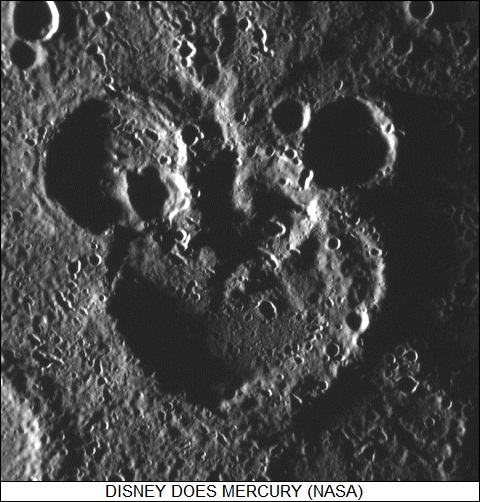
Apparently NASA people wanted to push their luck again, releasing an image taken by the MESSENGER Mercury orbiter of three overlapping craters that looked like Mickey Mouse. That made for a golden opportunity to cook up a conspiracy theory that mixed up NASA with Disney Corporation. It probably also created some consternation among Disney legal staff: "We'd sure like to sue somebody for intellectual property theft, but we can't figure out who."
* As noted in the series on world food production run here in 2011, a substantial proportion of global food output is simply wasted -- by inefficient distribution and storage in undeveloped countries, by simply being thrown out in wealthy ones. As mentioned by THE ECONOMIST, the USA has a slight edge over Europe in the use of the "doggy bag" or "doggy box", which restaurants provide to patrons who can't eat all their meal and want to take the leftovers home for the dog, or themselves for that matter.

While it's a perfectly sensible idea, it's generally not seen as attractive outside of the USA, coming across as pinchpenny at best and unhygienic at worst. That seems a bit shortsighted on first consideration, but on further thought it is easy to see how it might provoke disgust. However, food waste is a global problem, and doggy bags do provide a little bit of the solution at negligible overhead -- so one might hope it will catch on elsewhere.
I don't often eat in regular restaurants any more because I can't eat big meals, but when I was visiting my brother Terry and his family in Spokane a year or two back we all went to a restaurant to celebrate a birthday. I ordered a prime rib, which was tasty but more than I could eat; I asked for a doggy box, thinking Terry's obsessively affectionate golden retriever, Tucker, might appreciate it. We went back to Terry's house and Tucker came out to greet us. I said: "C'mere, Tucker!" -- and held out the box. He didn't understand right away, but once he stuck his nose in the box he just went SUCK! and inhaled the prime rib. I had problems getting rid of him for the rest of the evening.
COMMENT ON ARTICLE